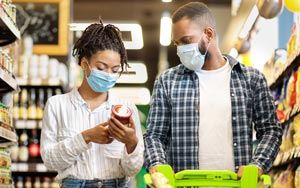by Ravi Pratap
Rolling out new vaccines for a new disease with an ASAP timeline is no small feat, and yet state and federal governments are making it happen. One component of their success so far is the QR (quick response) code, that square grid that can be often seen on labels and advertisements in the last year. Because these codes offer a touch-free way to transmit information, they have had a kind of renaissance during the pandemic.
Here is what independent retailers can learn from how governments have used these codes to vaccinate the population:
Provide More Information for “Conscious Consumers”
Governments and local healthcare facilities have embraced providing important information about COVID-19 vaccines via QR code, including details required by the Childhood Vaccine Injury Act. On the healthcare provider side: a visitor to the Bronx’s Montefiore Medical Center can scan a QR code in the facility to learn about vaccine side effects and contraindications before signing up for a shot.
Retailers can adopt this strategy and use QR codes to provide in-person customers the kind of information they can access instantly online. Whether shoppers are interested in ingredient sustainability, the working conditions in a clothing factory, or product reviews, retailers can post QR codes that satisfy their curiosity. This will be especially important as brick-and-mortar shopping comes back: retailers who can recreate the information density of online shopping are less likely to lose shoppers who want more details before making a purchase.
Maintain Distance or Pack the House
Vaccination centers around the U.S. have found success in checking patients in via QR code. This helps maintain physical distancing requirements without sacrificing accuracy. Retailers can adopt similar practices thanks to remote payment options introduced by PayPal and Venmo. By adding QR codes to merchandise, businesses can empower customers to check out without making physical contact with employees. In addition to reducing the spread of germs, this can help reluctant shoppers return sooner and give employees greater peace of mind about working.
QR codes can also help with the reverse phenomenon — bringing people closer together via “vaccine passports.” Vaccine passports use QR codes to store information about vaccination status and COVID test results. Airlines and certain federal governments are looking at ways to use these passports to facilitate travel. Independent retailers and venue owners could do something similar as a way of relaunching bigger events (when state guidelines permit): i.e., increase event capacity only when everyone in attendance can show proof of vaccination. In addition to boosting safety, this strategy could increase the likelihood that reluctant customers would return. New York already has such a program in place called the Excelsior Pass, while some other states, such as Florida and Texas, have banned certain vaccine passport use cases.
Power Partnerships with QR Codes to Get Back to Normal
Travel boards, nonprofits, airlines, and tech companies are collaborating to bring back international travel and tourism, particularly with vaccine passport-type projects.
Retailers can use a similar method, such as partnering with their Chamber of Commerce to publicly post QR codes that link to information about safety protocols in place in their shopping district or to outline requirements for various establishments within the zone, e.g., no masks required while walking outside, masks required in stores, etc. This can both ease anxious customers and prevent employees from having to repeat safety requirements over and over.
Stand on the Shoulders of Giants
With the health of millions of citizens at stake, governments had to act fast to come up with workable solutions for extremely complex challenges. As those solutions let the country reopen, independent retailers can adapt some of these successful techniques that governments have employed to create safe, welcoming environments for their returning customers.
Ravi Pratap Maddimsetty is the cofounder and CTO at MobStac, a QR code generator and mobile marketing platform for independent retailers and companies, and brands of all sizes.
